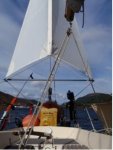TRUNDLETRUC
Well-Known Member
There are always threads on this forum about anchoring but nothing about reducing the strain on the chain. Our yacht is fairly light with high top sides and in a blow sails itself wildly from side to side. When the yacht changes direction and falls back on the other tack the "Angle of Dangle"of the chain becomes more horizontal than at any other time showing that there is a lot more of tension. I have tried many ways to try and reduce this but the only sure way to stop the swinging is to rig a spring from the stern of the boat to a point on the chain some way in front of the stem holding it permanently on one tack.
My question is, to the scientists/engineers amongst us (Viv?), with your strain gauges does a yacht, set at the minimum angle to hold it on one tack, but a constant load, generate more tension on the chain than the tension generated when falling onto the new tack if anchoring free?
Is there any research? It is quite an important consideration which depending on the result could help you make the most efficient use of the length of chain you have.
I look forward to some facts from the experts.
My question is, to the scientists/engineers amongst us (Viv?), with your strain gauges does a yacht, set at the minimum angle to hold it on one tack, but a constant load, generate more tension on the chain than the tension generated when falling onto the new tack if anchoring free?
Is there any research? It is quite an important consideration which depending on the result could help you make the most efficient use of the length of chain you have.
I look forward to some facts from the experts.

